Ganesh Chaturthi Festival
Ganesh Chaturthi festival is a Hindu holiday commemorating the birth of Lord Ganesh or Ganesha, the God of Wisdom and Prosperity. The Festival of Ganesh Chaturthi is held during the new moon on the month of Bhadrapada, and can last from five days to a week or an average of about ten days. In some areas, the celebrations of Ganesh Chaturthi even reach up to twenty one days! The community and people also decide which day is considered important: for traditional devotees it is the first day, whereas others consider the final day as the highlight of the celebration.
| Ganesh Chaturthi Cards | ||||
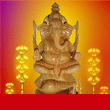 |
 |
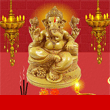 |
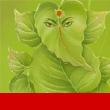 |
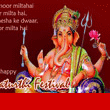 |
| Ganesh Chaturthi | Lord Ganesha | History | Celebration | Date | Gifts |
| Cards | Greetings | SMS | Wallpaper | Pictures | Scraps |
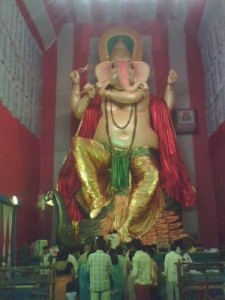 Lord Ganesha: The God of Success and Properity
Lord Ganesha: The God of Success and Properity
Because Ganesha is considered as the God of Wisdom and Prosperity, it is believed that his blessing is necessary for individual fulfillment in life. He is worshiped before the beginning of all religious activities in Hinduism. Legend has it that he is the son of Lord Shiva and Goddess Parvati, and brother to Lakshmi (the Goddess of Wealth), Kartikeya (the General of the Gods), and Saraswati (the Goddess of Learning). Many myths circulate about his birth and his appearance as an deity with an elephant-head. He is also known to ride on a Mooshak or a rat, and takes a liking to Modaks, a type of Indian delicacy.
Ganesha’s Birth
According to legend, Parvati created Ganesha by breathing life into a sandalwood dough. She then ordered him to stand guard at the entrance of her home as she took her bath. When Shiva arrived at his home, Ganesha refused to let him in, leading the god to behead him in anger. At the sight of her dead son, Parvati became furious and demanded that Shiva revive Ganesha. At her request, he revived Ganesha by attaching the head of an elephant to his body.
How Ganesha Became Ganpati
Another myth illustrates how Ganesha became highly respected. When the Gods decided to choose a leader, they choose two brothers – Ganesh and Kartikeya – to compete for the title through a race. Whoever came in first in a three-round race around the earth would be named Ganaadhipati or “leader”. Ganesh chose a rat as his vehicle, while Kartikeya opted for a peacock. Although Kartikeya took off early in the race, Ganesh chose to pay his respects to his parents first by going around them three times. When asked why he chose this instead of going around the earth, he claimed, “The presence of my parents permeate the whole universe, and circling around them is worth more than racing around the earth.” At his intelligent response, everybody proclaimed him as the winner, and blessed him with the title of Ganaadhipati or leader. Nowadays, he is now known simply as Ganpati.
The Snake, the Rat, and the Moon
Another story has it that revealed the symbolic significance of the snake, the rat, and Ganesha’s elephant tusk during the Ganesh Chaturthi festival. On Ganesha’s birthday, Parvati cooked a lot of sweet porridge and twenty one types of food for Him. He ate so much that his belly was about to burst. At night, while He was riding His rat on His nightly rounds, His mouse fainted at the sight of a snake. He took the snake and wrapped it around his waist to adjust his large belly, causing laughter to descend from the sky. When He looked up, he saw the moon making fun of him. In his fury, he snapped off one of his elephant tusks and hurled it at the laughing moon. Parvati saw what the moon had done to her son, and from thereon cursed anyone who dared look at the moon during Ganesh Chaturthi festival.
The snake, the rat, and the moon are significant symbols in the Ganesh chaturthi festival because it is a philosophical analogy of the universe. The large belly of Ganesha symbolizes the whole universe, with Parvati (as his mother) as the “primordial energy” of this universe. Inside His belly are the seven realms above, the seven oceans, and the seven realms below. These realms are held together by a cosmic energy called kundalini, symbolized by the snake which Ganesha used as a belt. The rat stands for the human ego, and much like his rat, there is a need for Ganesha to control our ego in order to obtain His consciousness. Furthermore, because of the moon’s mockery of Ganesha, devotees do not look at the moon because Parvati had cursed it for its disrespectfulness.
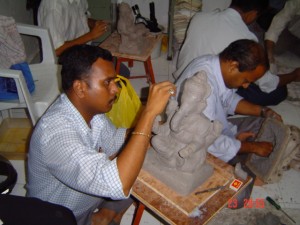
Photo Credit: Eco-friendly Ganesha Idol (from wikipedia)
Ganesh Chaturthi Celebrations
Ganesh Chaturthi Festival is held in many areas across India, notably the states of Maharashtra, Andhra Pradesh, Tamil Nadu, and Karnataka. It began under the great Maratha ruler named Chatrapati Shivaji Maharaja as a means to promote national culture. Later, it was redefined and revived by a freedom fighter by the name of Lokmanya Tilak, who used the festival to defend their freedom from the British who had banned public gatherings. This unity revived nationalism and religious faith across the country, and the festival became a venue for leaders to encourage revolt against Western rule.
Now, it is no longer a political venue but a community gathering of people from all backgrounds. Ganesha statues are placed in and out of homes, and intricate designs of lights, flowers, mirrors, and all types of decorations are set up. Prayer services called poojas are held everyday during Ganesh Chaturthi festival. Artists from different communities compete with one another to create the best Ganesh idol in the celebration. These artisans usually produce very large statues, towering at a height from ten to thirty meters! These idols are the centerpieces of the grand procession in the community, and after one, three, five, seven, or ten days, they are immersed into the sea accompanied by much dancing, singing, traditional drumbeats, and the chanting of “Ganesh Maharaj Ki Jai (Hail Lord Ganesh)!”. As the idol disintegrates in the water, people end the festival with chants of “Ganpati bappa morya, pudcha varshi laukar ya (Hail Lord Ganesh, return again next year).”